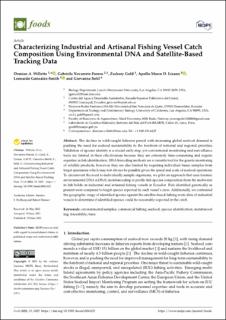Characterizing Industrial and Artisanal Fishing Vessel Catch Composition Using Environmental DNA and Satellite-Based Tracking Data
Willette, Demian A.; Navarrete-Forero, Gabriela; Gold, Zachary; Lizano, Apollo Marco Dalonos; Gonzalez-Smith, Leonardo; Sotil, Giovanna
Peer reviewed, Journal article
Published version
Permanent lenke
https://hdl.handle.net/11250/3004586Utgivelsesdato
2021Metadata
Vis full innførselSamlinger
Originalversjon
Willette, D.A., Navarrete-Forero, G., Gold, Z., Lizano, A.M.D., Gonzalez-Smith, L. & Sotil, G. (2021). Characterizing industrial and artisanal fishing vessel catch composition using environmental DNA and satellite-based tracking data. Foods, 10(6): 1425. doi: 10.3390/foods10061425Sammendrag
The decline in wild-caught fisheries paired with increasing global seafood demand is pushing the need for seafood sustainability to the forefront of national and regional priorities. Validation of species identity is a crucial early step, yet conventional monitoring and surveillance tools are limited in their effectiveness because they are extremely time-consuming and require expertise in fish identification. DNA barcoding methods are a versatile tool for the genetic monitoring of wildlife products; however, they are also limited by requiring individual tissue samples from target specimens which may not always be possible given the speed and scale of seafood operations. To circumvent the need to individually sample organisms, we pilot an approach that uses forensic environmental DNA (eDNA) metabarcoding to profile fish species composition from the meltwater in fish holds on industrial and artisanal fishing vessels in Ecuador. Fish identified genetically as present were compared to target species reported by each vessel’s crew. Additionally, we contrasted the geographic range of identified species against the satellite-based fishing route data of industrial vessels to determine if identified species could be reasonably expected in the catch.

